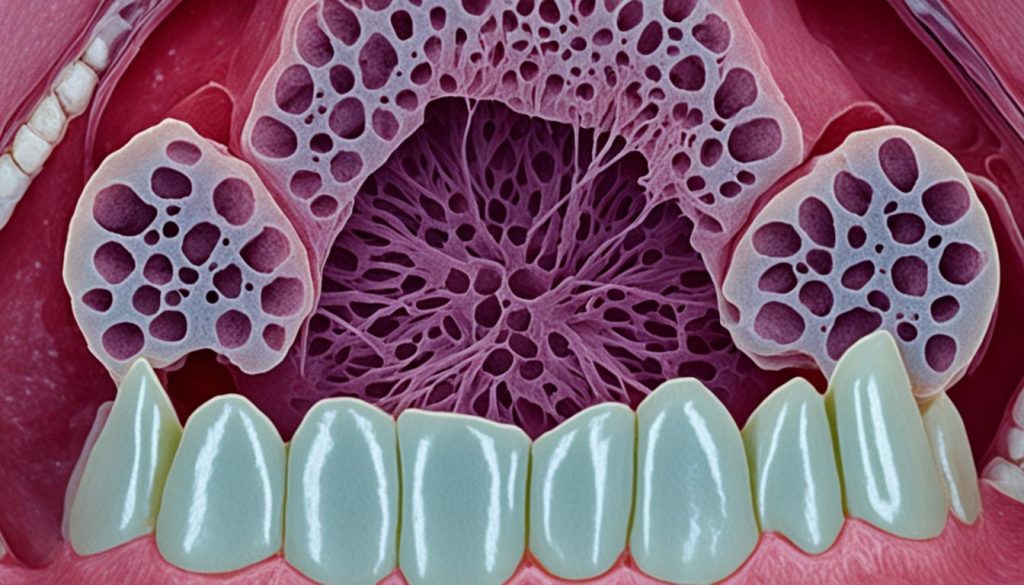If you’ve had a tonsillectomy, you may be wondering “can tonsils grow back?” It’s a valid concern, and in this article, I will explore the possibility of tonsil regrowth and the associated factors. Tonsil regrowth, although rare, can occur when residual tissue from the procedure regenerates. However, it is important to note that regrowth is usually partial rather than complete.
If you have experienced recurring tonsillitis or are concerned about tonsil recurrence, understanding the rate of tonsil re-growth and the potential for secondary tonsil growth is crucial. We’ll delve into these topics to provide you with a comprehensive understanding of tonsil regrowth after surgery.
In the following sections, we will discuss the symptoms of tonsil regrowth, the impact of tonsil regrowth on your health, and what you can do if your tonsils regrow after a tonsillectomy. So, let’s dive in and get a better grasp of this intriguing topic!
Symptoms of Tonsil Regrowth
If your tonsils grow back, you might notice bumps where the tonsils used to be. However, this regrowth doesn’t always cause symptoms. In some cases, the regrown tonsils can become infected and swollen, similar to the original tonsils. It’s important to note that a sore throat or infection doesn’t necessarily indicate tonsil regrowth. If you suspect your tonsils are growing back, it’s advised to consult your doctor.
Can You Still Get a Sore Throat Without Tonsils?
Even after a tonsillectomy, it is still possible to experience a sore throat. While the procedure is generally effective at reducing sore throats, it doesn’t guarantee complete immunity. A study found that 95% of surveyed individuals reported a decrease in sore throats after surgery. However, factors such as allergies, colds, smoke, and dry air can still cause a sore throat.
If you’ve undergone a tonsillectomy and are experiencing a sore throat, it’s important to evaluate other potential causes before assuming tonsil regrowth. Allergies, viral infections, and environmental irritants can all contribute to throat discomfort. Consult with your healthcare provider to determine the cause of your symptoms and to discuss appropriate treatment options.
While it may seem counterintuitive to continue experiencing a sore throat after having your tonsils removed, it’s important to remember that the surgery primarily aims to reduce recurrent tonsillitis and related complications. Even without tonsils, the throat can still be susceptible to various irritants and infections.

Can You Still Get Strep Throat Without Tonsils?
Having your tonsils removed reduces the risk of developing strep throat. However, it doesn’t eliminate the possibility entirely. Strep throat is an infection caused by streptococcus bacteria. While surgery may lower the chances of getting strep throat, it can still occur even after tonsil removal. The decision to perform a tonsillectomy for recurrent infections and strep throat has become controversial in recent years.
If you’ve had a tonsillectomy, you may be concerned about the potential complications and the risk of developing strep throat. While the removal of the tonsils reduces the likelihood of this infection, it’s important to understand that it does not guarantee complete immunity. Strep throat can still occur due to factors such as exposure to the streptococcus bacteria, which can be present in the environment or transmitted from person to person.
Strep throat is characterized by symptoms such as severe sore throat, difficulty swallowing, fever, headache, and swollen lymph nodes. If you experience these symptoms, it is important to consult your healthcare provider for an accurate diagnosis and appropriate treatment. Treatment often involves antibiotics to fight the infection and relieve symptoms.
It’s worth noting that recurrent tonsillitis, even after a tonsillectomy, may indicate the presence of residual tonsil tissue or complications from the surgery. In some cases, a secondary surgery may be necessary to address these issues, but this is relatively rare and usually not required.
It’s vital to prioritize proper hygiene practices, such as frequent handwashing and avoiding close contact with individuals who have a confirmed strep throat infection, to minimize the risk of contracting strep throat even after a tonsillectomy.
The image above illustrates the potential complications associated with tonsillectomy. While this procedure is generally safe, like any surgery, there are risks involved. It’s essential to discuss these risks with your healthcare provider before deciding to undergo a tonsillectomy.
- Tonsillectomy reduces the risk of developing strep throat but does not eliminate it entirely.
- Strep throat is caused by streptococcus bacteria and can still occur even after tonsil removal.
- Consult your healthcare provider if you experience symptoms of strep throat after a tonsillectomy.
- Proper hygiene practices can help reduce the risk of contracting strep throat.
While the chance of getting strep throat after a tonsillectomy is lower, it’s important to be aware of the possibility and seek medical attention if symptoms arise. Your healthcare provider can provide a proper diagnosis and recommend suitable treatment options.
Factors Affecting Tonsil Regrowth
Tonsil regrowth, although relatively rare, can occur under certain circumstances. Several factors may increase the likelihood of tonsil regrowth after a tonsillectomy. These factors include:
- Tonsillectomy at a young age: Having the tonsils removed during childhood has been associated with a slightly higher risk of regrowth.
- Tonsillotomy instead of full tonsillectomy: Opting for a tonsillotomy, a partial removal of the tonsils, may result in a higher chance of regrowth compared to a complete tonsillectomy.
- Experiencing allergies or upper respiratory infections: These conditions can potentially stimulate tissue regeneration in the tonsil area.
- History of acute tonsillitis: Individuals who had frequent episodes of acute tonsillitis prior to the surgery may have a slightly increased risk of tonsil regrowth.
It is important to note that these factors do not guarantee tonsil regrowth, but they may contribute to an elevated likelihood. Understanding these factors can help individuals and healthcare providers make informed decisions regarding tonsillectomy revision and monitoring for potential regrowth.
Can Tonsils Grow Back? Treatment for Tonsil Regrowth
In most cases, no treatment is necessary if your tonsils regrow after surgery. However, if you experience infections or other issues related to the regrowth, your doctor may recommend the same treatments used prior to the tonsillectomy. Antibiotics are often prescribed for infections like strep throat. In severe cases, a second surgery may be recommended.
If you notice any symptoms of recurrent tonsillitis or complications after tonsil regrowth, it’s important to consult with your healthcare provider. They will evaluate your condition and determine the most appropriate course of treatment. Depending on the severity and frequency of infections, antibiotics may be prescribed to alleviate symptoms and eliminate the infection.

In some rare cases, a second surgery may be necessary to address the regrowth. A tonsillectomy revision can remove the regrown tonsil tissue and prevent further complications. However, this option is typically considered if conservative measures fail to manage the symptoms and recurring infections.
It’s crucial to follow your doctor’s recommendations and maintain regular follow-up appointments to monitor the regrowth and evaluate the effectiveness of the chosen treatment approach. By actively addressing tonsil regrowth and any associated complications, you can improve your overall quality of life and reduce the risk of recurrent infections.
Managing Regrowth of Tonsil Tissue
If you’ve experienced regrowing tonsils, it’s important to stay vigilant for signs of recurring tonsillitis or secondary tonsil hypertrophy. These conditions can lead to chronic throat infections and even symptoms of sleep apnea. If you notice persistent throat discomfort, difficulty swallowing, or disrupted sleep patterns, it’s advisable to consult your healthcare provider for further evaluation.
In cases where tonsil or adenoid regrowth is confirmed, treatment options will depend on the severity of the condition. For recurring infections, your doctor may prescribe antibiotics to address the bacterial cause. In situations where the regrown tonsils are significantly enlarged and causing breathing or swallowing difficulties, steroids may be prescribed to reduce inflammation and shrink the tonsils. In more severe cases, surgical removal of the regrown tissue may be necessary to alleviate the symptoms and prevent complications.
It’s important to note that while tonsil regrowth can occur, the chances of a full regrowth are extremely rare. However, regular monitoring of your throat health is still recommended, especially if you have a history of tonsil-related issues. Being proactive in managing any potential regrowth can help ensure your overall well-being and prevent any complications associated with recurrent tonsillitis or secondary tonsil hypertrophy.
Understanding Tonsil Regrowth and Treatment Options
After undergoing a tonsillectomy, it is possible for your tonsils to regrow, although it is relatively uncommon. In most cases, if regrowth does occur, it is partial and does not typically pose a serious concern. However, if the regrowth of tonsil tissue does cause symptoms, there are treatment options available.
The treatment options for tonsil regrowth are similar to those used before the initial tonsillectomy. This may include antibiotic therapy for infections or other medications to alleviate related symptoms. It is important to note that the chances of needing a second surgery due to regrowing tonsils are rare.
If you suspect that your tonsils may be regrowing and causing symptoms, it is recommended to consult with your doctor for appropriate evaluation and management. They will be able to assess your condition and provide the necessary guidance and treatment options to address the regrown tonsils effectively.




